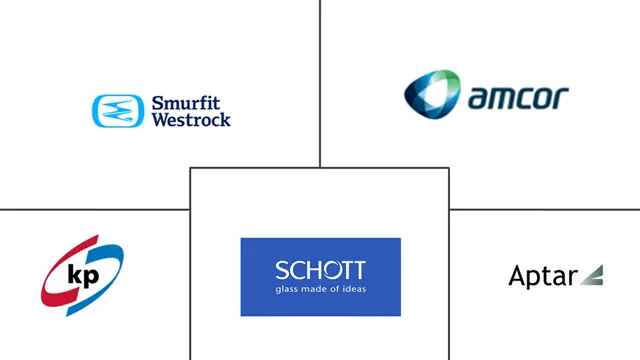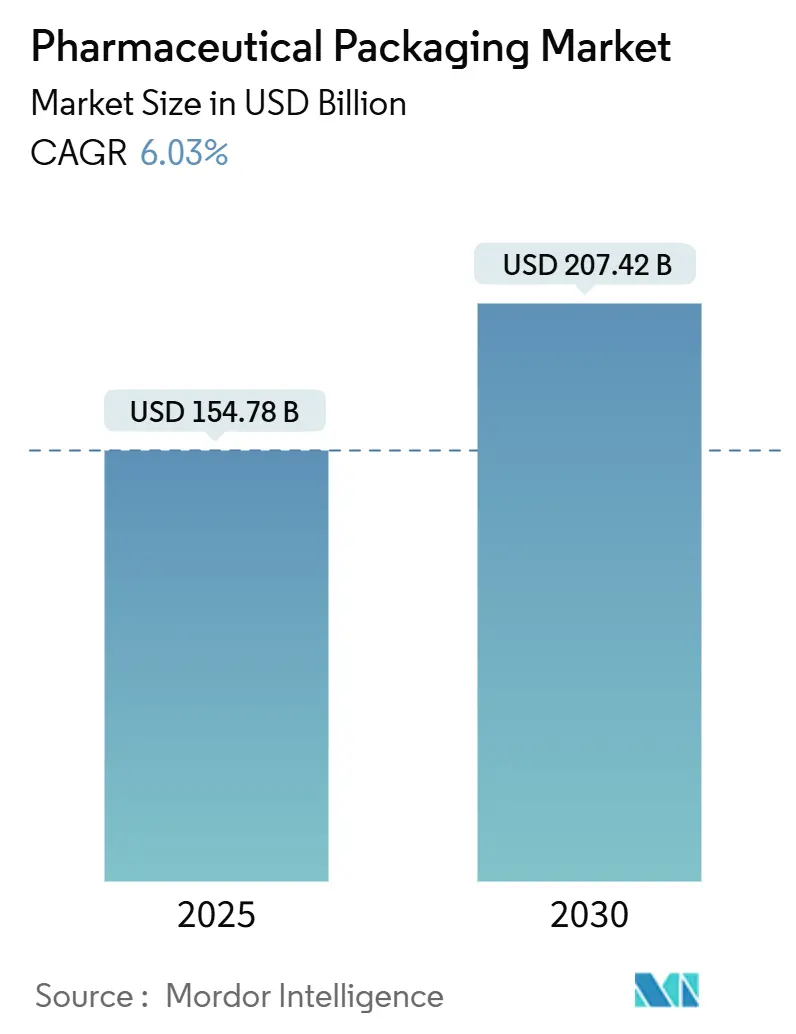
Pharmaceutical Packaging Market Analysis by Mordor Intelligence
The pharmaceutical packaging market size reached USD 154.78 billion in 2025 and is forecast to rise to USD 207.42 billion by 2030, advancing at a 6.03% CAGR. Over the next five years, the increasing demand for biologics, stricter global traceability regulations, and widespread sustainability targets will continue to drive capital investment in new fill-finish lines, high-barrier materials, and circular-ready designs. Demand for flexible pack volumes that match smaller, personalized therapy batches is expected to expand as gene and cell therapies reach commercial scale. North America remains the largest regional contributor, supported by DSCSA-driven serialization, while the Asia-Pacific’s sizable 8.96% CAGR reflects rising domestic drug production and broadening health coverage.[1]FDA, “DSCSA Requirements,” fda.gov Material strategies are in flux: plastics still dominate, yet bio-based polymers, aluminum-free blisters, and post-consumer-recycled films are quickly transitioning from pilot to production as EU and US PFAS curbs near enforcement. Meanwhile, price swings in polyethylene, polypropylene, and PET keep margins tight, encouraging longer supplier contracts and vertical integration by larger converters.
Key Report Takeaways
- By material, plastics led the pharmaceutical packaging market, accounting for 45.64% of the market share in 2024; biopolymers are projected to expand at an 8.54% CAGR through 2030.
- By packaging level, primary packaging accounted for 60.32% of the pharmaceutical packaging market size in 2024 and is projected to advance at a 7.42% CAGR through 2030.
- By product type, bottles captured a 28.32% share of the pharmaceutical packaging market size in 2024, while prefilled syringes posted the fastest 8.32% CAGR from 2024 to 2030.
- By geography, North America commanded a 35.32% share of the pharmaceutical packaging market in 2024; the Asia-Pacific region recorded the fastest 8.96% CAGR through 2030.
Global Pharmaceutical Packaging Market Trends and Insights
Drivers Impact Analysis
| Driver | (~) % Impact on CAGR Forecast | Geographic Relevance | Impact Timeline |
|---|---|---|---|
| Aging population and chronic disease prevalence | +1.2% | Global, with concentration in North America & Europe | Long term (≥ 4 years) |
| Biologics and injectable pipeline expansion | +1.8% | Global, led by North America & Europe | Medium term (2-4 years) |
| Sustainability-driven material substitution | +0.9% | Europe & North America core, expanding to APAC | Medium term (2-4 years) |
| Digital traceability mandates (DSCSA, EU-FMD) | +0.7% | North America & EU, with spillover to other regions | Short term (≤ 2 years) |
| AI-enabled adaptive fill-finish lines | +0.4% | North America & Europe, early adoption in APAC | Medium term (2-4 years) |
| Rise of at-home/decentralized trials needing mail-ready packs | +0.3% | Global, with early gains in North America & Europe | Short term (≤ 2 years) |
| Source: Mordor Intelligence | |||
Aging population and chronic disease prevalence
Rising median ages drive up long-term therapy volumes, underpinning consistent demand for calendar blisters, large-print labels, and one-hand-open vials that aid adherence among patients with reduced dexterity. Germany’s 2024 vaccination shifts, with pneumococcal doses up 23% and meningococcal B up 52%, illustrate broader preventive care uptake among seniors. Packaging suppliers respond with connected packs that log opening events and forward adherence data to care teams. Growth in smart closures and NFC-enabled cartons is expected to intensify as payers link reimbursement to real-world outcomes.
Biologics and injectable pipeline expansion
Prefilled syringes sit at the core of new biologic launches because they simplify self-administration, minimize contamination risks, and reduce waste during the fill-finish process. BD’s iDFill syringe embeds RFID for instant verification, while its Neopak XtraFlow design handles viscous formulations that were once vial-only. GMP Annex 1 revisions are accelerating demand for ready-to-use glass tubing and polymer containers that bypass washing and depyrogenation steps, helping CDMOs scale capacity without the need to construct new cleanrooms.
Sustainability-driven material substitution
Legislators now tie producer fees to recyclability, making end-of-life design a margin driver rather than a marketing add-on. Dai Nippon Printing’s aluminium-free polypropylene PTP blister achieves water-vapour barriers below 0.2 g/m²/day yet qualifies for established recycling streams.[2]Dai Nippon Printing, “Aluminium-free PTP Film,” prtimes.jp Novo Nordisk switched from multi-layer plastic trays to paper-based inserts, reducing weight and cube footprint while maintaining sterility. Early adopters who validate lower-carbon pack formats in regulated markets gain a pricing edge and smoother compliance when EU recyclability mandates take effect in 2030.
Digital traceability mandates (DSCSA, EU-FMD)
Full-scale serialization in the United States is expected to transition from lot-level to package-level tracking by 2025. Each smallest saleable unit now carries a GTIN, a unique serial number, lot, and expiry date in both human- and machine-readable formats, supported by interoperable data exchange across wholesalers, repackagers, and dispensers. European markets face parallel requirements under the Falsified Medicines Directive, compelling converters to build global code libraries and integrate tamper-evident seals without slowing line speeds.
Restraints Impact Analysis
| Restraint | (~) % Impact on CAGR Forecast | Geographic Relevance | Impact Timeline |
|---|---|---|---|
| Petro-derivative resin price volatility | -1.1% | Global, with acute impact in Asia-Pacific manufacturing hubs | Short term (≤ 2 years) |
| Capital-intensive sterility and validation requirements | -0.8% | Global, particularly affecting smaller manufacturers | Medium term (2-4 years) |
| Looming PFAS/fluoropolymer restrictions in EU and US | -0.6% | Europe & North America, with supply chain spillover globally | Medium term (2-4 years) |
| Source: Mordor Intelligence | |||
Petro-derivative resin price volatility
Supply disruptions and force majeure events led to a 1.1% increase in PET prices in June 2024, further tightening already narrow converter margins. Pharmaceutical contract material specs restrict rapid grade switches, forcing many converters to absorb cost spikes or renegotiate long contracts. Corrugated shippers also face higher fibre costs, with a USD 70 per-ton increase announced for January 2025.
Capital-intensive sterility and validation requirements
In 2024, FDA warning letters frequently cited deficiencies in contamination control and equipment maintenance among sterile drug producers, underscoring the cost of compliance upgrades. EU GMP Annex 1 raises the bar further, driving investments in isolators, gloveless robotic filling, and 100 % in-line visual inspection. Smaller packaging plants struggle to finance Class A/B environments, prompting many to outsource to ready-to-use specialist suppliers.
Segment Analysis
By Material: Sustainability Drives Innovation
Plastics retained 45.64% of the pharmaceutical packaging market share in 2024, primarily driven by HDPE bottles, PP closures, and PET blisters that strike a balance between cost and barrier needs. Yet the segment’s growth moderates as brand owners court circularity objectives. Within the plastics industry, the pharmaceutical packaging market size for PP-based syringes is rising steadily, thanks to break-resistant cyclic olefin options. Glass remains indispensable for light- and moisture-sensitive biologics; Type I borosilicate vials dominate cytotoxic fills, despite their higher weight and shatter risk. Metals play a niche role in aerosol and implantable devices.
Momentum is gathering around bio-attributed resins, recycled PET mid-barrier webs, and paper-based pill bottles, such as Allegheny Health Network’s Tully Tube pilot. Developers weigh shelf-life assurance, extractables profiles, and line changeover costs before a wide release, yet early adopters often win procurement tenders from hospitals, incorporating sustainability scoring into vendor audits.
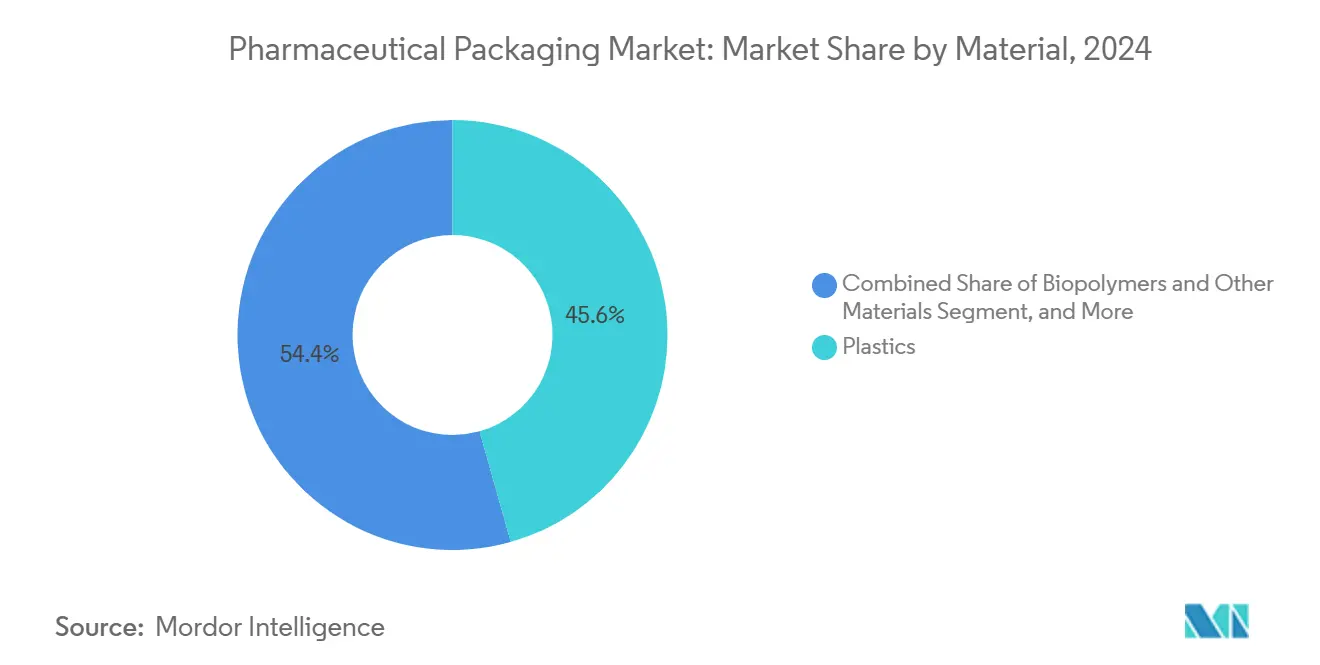
Note: Segment shares of all individual segments available upon report purchase
By Packaging Level: Primary Packaging Dominance
Primary packaging accounted for 60.32% of the pharmaceutical packaging market size in 2024, a position it secures by providing the first line of defense between the drug and the environment. Bottles, vials, ampoules, and prefilled syringes dominate this layer because they must meet sterility, extractables, and barrier targets that secondary and tertiary packs simply backstop. Within sterile injectables, ready-to-use glass tubing and polymer vials are gaining traction, saving fill-finish plants the cost and time associated with online washing and depyrogenation, while aligning with updated EU GMP Annex 1 contamination control rules. Growth also tracks decentralised clinical trials that ship temperature-controlled kits direct to patients, a model that favors tight-tolerance primary containers capable of surviving both courier handling and domestic refrigeration.
Secondary packaging serves as an information carrier and brand vehicle, wrapping primary containers with cartons, sleeves, and inserts that meet multilingual labeling and serialization requirements. Digital inkjet presses enable lot-size-one runs, allowing trial sponsors to regionalize artwork without increasing inventory. Tertiary packaging, often overlooked, now commands renewed focus as biologics volumes and direct-to-patient logistics expand. DS Smith’s fibre-based TailorTemp maintains 2-8 °C for 36 hours, proving that corrugated systems can meet cold-chain standards while remaining fully curbside recyclable. Rising resin and paper prices are putting pressure on margins across all three layers, prompting large converters to seek multi-year raw material contracts and in-house recycling loops that help mitigate volatility.
By Product Type: Prefilled Syringes Lead Growth
Bottles retained the largest 28.32% share of the pharmaceutical packaging market in 2024, thanks to their entrenched solid-oral and liquid OTC lines that operate at high speeds and accept commodity HDPE or PET. Continuous compression and integrated induction-seal stations help keep unit costs low, while closure makers incorporate child-resistant and senior-friendly features to comply with evolving safety codes. Glass bottles remain essential for light-sensitive cough syrups, although concerns about weight and breakage have sparked interest in amber-tinted PET that meets USP <661>. Innovation within bottles now centers on digital connectivity; Gerresheimer’s Gx Cap measures opening events and streams adherence data to ePRO dashboards during clinical studies.
Prefilled syringes are projected to post the fastest 8.32% CAGR through 2030, mirroring the biologics boom and the shift toward at-home administration. BD’s iDFill syringe integrates RFID, allowing hospital staff to authenticate units nearly instantly. Its Neopak XtraFlow design handles high-viscosity monoclonals without compromising glide force. Polymer options such as cyclic olefin polymer reduce breakage risk and eliminate tungsten residues that can destabilize proteins. Vials and ampoules remain staples for lyophilized drugs, with ready-to-use nests shortening line changeovers. Blister packs are evolving toward smart formats that embed microcircuits to time-stamp each cavity opening, a feature valued by sponsors executing decentralized trials that hinge on verified adherence.
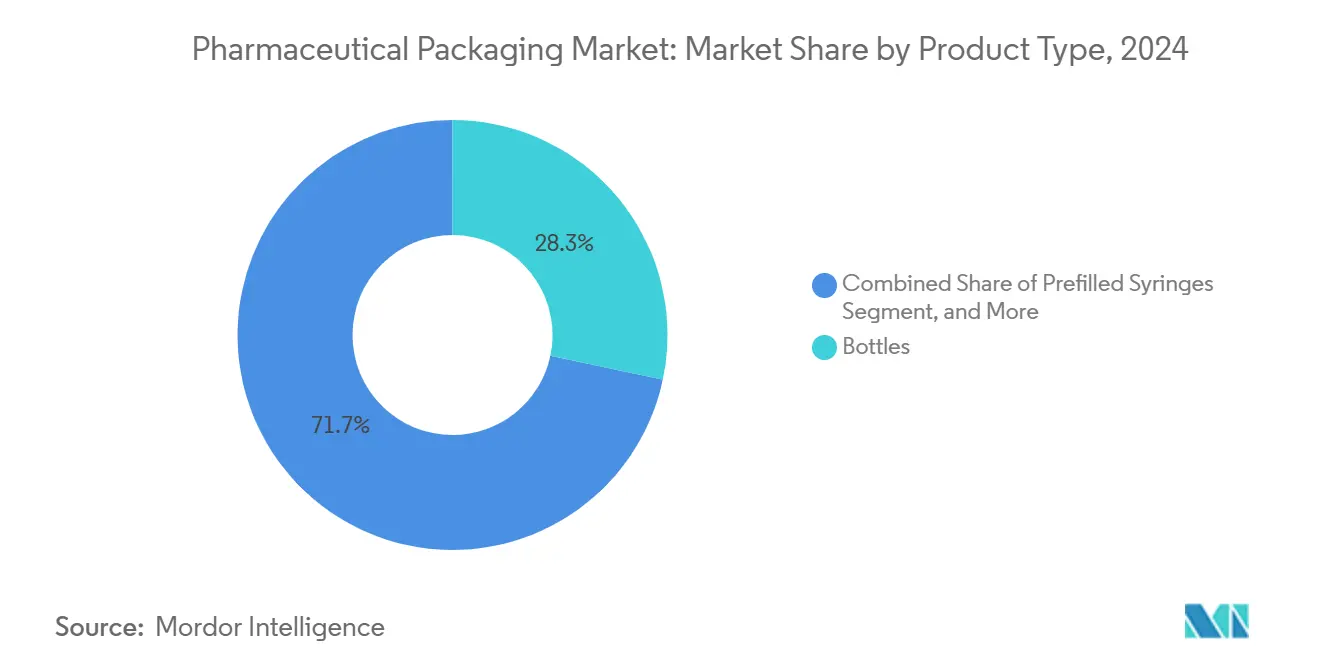
Note: Segment shares of all individual segments available upon report purchase
Geography Analysis
North America accounted for 35.32% of the pharmaceutical packaging market share in 2024, driven by significant investments in biologics and advanced DSCSA serialization mandates. U.S. manufacturers alone are investing USD 160 billion in new fill-finish and API plants through 2025, a trend that drives demand for sterilizable polymers, ready-to-use glass, and high-capacity cold-chain shippers. The region also pilots AI vision systems that scan for sub-100 µm particulates at line speed, lowering recall risk and strengthening brand trust.
Europe balances ambitious sustainability regulations with energy cost pressures. The forthcoming Packaging and Packaging Waste Regulation requires every format to be recyclable by 2030, escalating interest in monomaterial blisters and paper-based pill bottles.[3]Oliver Healthcare Packaging, “EU Packaging & Packaging Waste Regulation: Impact on Healthcare,” Oliverhcp.com Germany’s pharmaceutical output slipped 1.5% in 2024, yet its R&D pipelines remain rich in mRNA and gene therapies that require ultra-low-temperature packaging. PFAS restrictions, effective in 2026, force material requalification, offering an early-mover advantage to suppliers with fluorine-free barrier films.
The Asia-Pacific region grows at the fastest rate of 8.96% CAGR through 2030, driven by the expanding CDMO footprints of China and India, as well as the widening of public health coverage. Local regulators align sterility rules with ICH and PIC/S guides, pushing packaging plants to adopt ISO 5 barriers and full-line serialization. Yet the region faces geopolitical headwinds; China’s updated Anti-Espionage Law complicates technology transfer for track-and-trace systems, prompting multinationals to diversify sourcing across ASEAN markets. Japanese converters, renowned for their precision molding, secure export orders for COP syringes as global brands hedge against dependence on a single country.
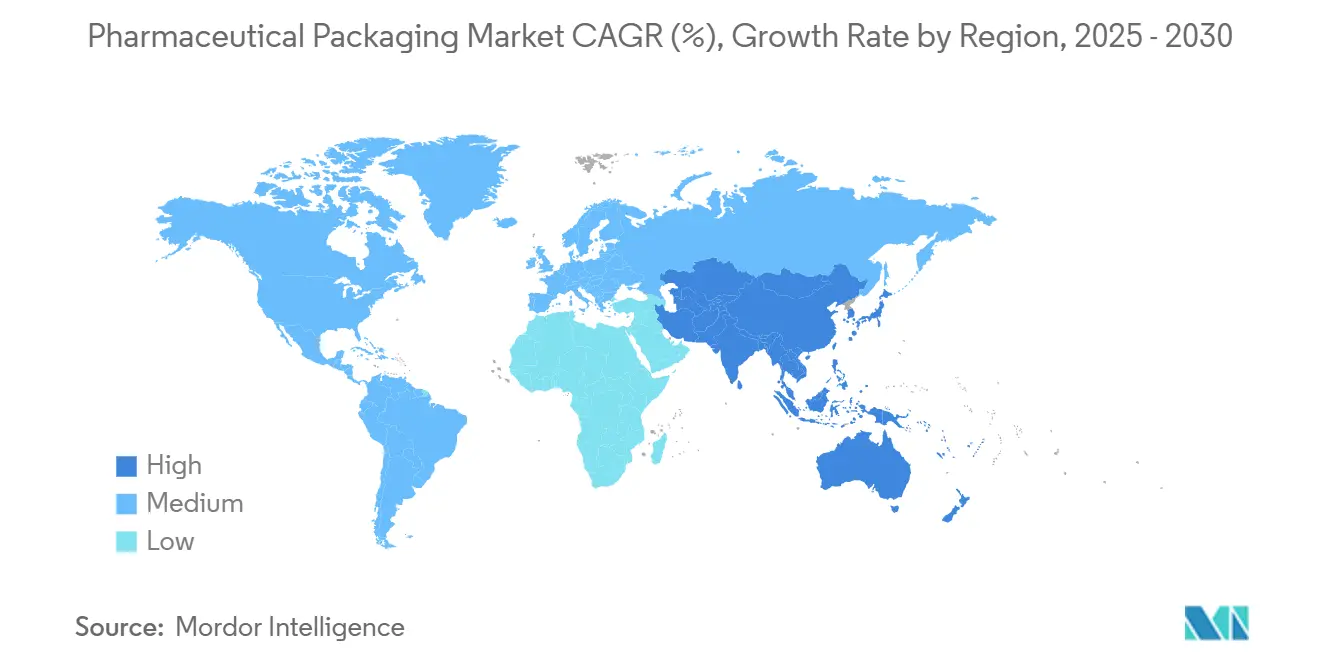
Competitive Landscape
The sector remains moderately fragmented, yet scale advantages are widening. Amcor, Gerresheimer, West Pharmaceutical Services, and Schott collectively command a significant share of the revenue. Their multi-continent networks assure business continuity when single-site outages occur, an attribute prized by risk-averse pharma buyers.[4]Packaging School, “Top 5 Packaging Industry Mergers & Acquisitions (M&A) Deals in 2024,” Packagingschool.com
Consolidation reshapes portfolios around sustainability and biologics expertise. Amcor’s USD 8.4 billion merger with Berry Global fuses specialty films with down-gauged bottle know-how, while Novo Holdings’ Catalent acquisition plugs drug-substance through final-pack gaps for complex injectables. Syntegon’s tie-up with Telstar marries isolator design to high-speed cartoners, enabling turnkey syringe lines that shorten project timelines for CDMOs targeting accelerated approvals.
Innovation fuels mid-tier differentiation. TekniPlex validated a 30% post-consumer-recycled PET blister that meets USP <661.1> extractables limits, winning early orders from EU generics makers. DS Smith’s TailorTemp® fibre shipper proves corrugated substrates can hold cold-chain loads, prompting vaccine producers to rethink EPS crates. Digital health convergence opens another frontier; Gerresheimer’s smart cap and Bormioli Pharma’s EasyRec dual-chamber pack illustrate how packaging now straddles drug delivery, patient engagement, and data analytics, raising competitive barriers for firms that lack electronics or software partners.
Pharmaceutical Packaging Industry Leaders
-
Amcor PLC
-
Schott AG
-
Smurfit WestRock
-
Klöckner Pentaplast Group
-
AptarGroup Inc.
- *Disclaimer: Major Players sorted in no particular order
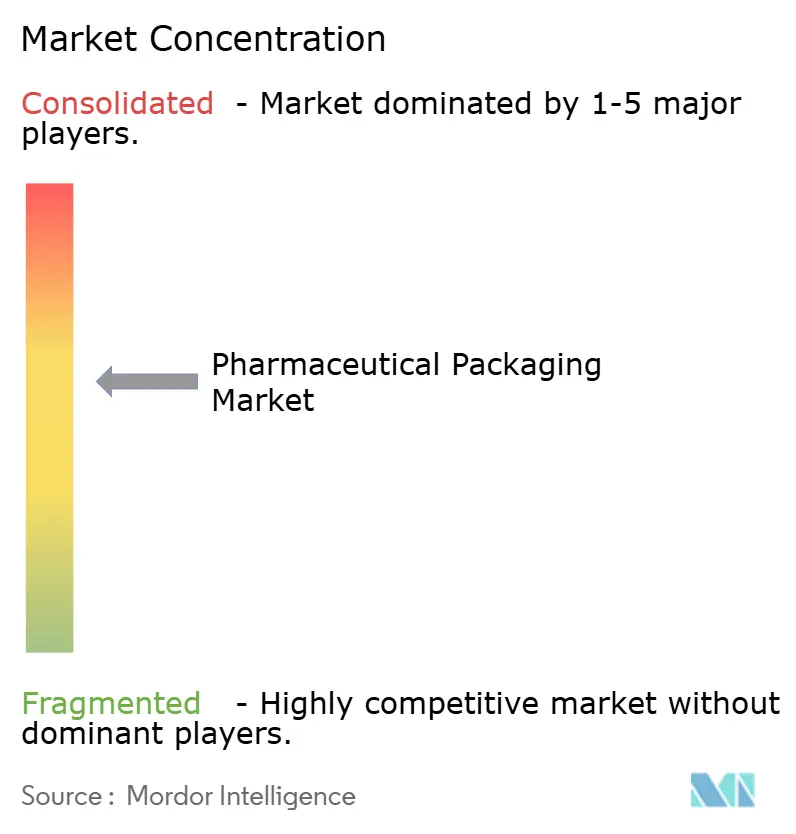
Recent Industry Developments
- June 2025: TOPPAN Holdings confirmed participation at INTERPHEX Japan, showcasing fibre-based blisters and AI inspection modules.
- May 2025: Gerresheimer introduced the Gx Cap connected tablet container at Pharmapack 2025.
- February 2025: Novo Holdings finalised its USD 16.5 billion Catalent purchase, expanding biologics packaging capacity.
- January 2025: DS Smith unveiled TailorTemp®, a fully recyclable fibre shipper that maintains cold chain for 36 hours.
Global Pharmaceutical Packaging Market Report Scope
The Pharmaceutical Packaging Market Report is Segmented by Material (Plastics, Glass, Metal, Paper and Paperboard, and Biopolymers and Other Materials), Packaging Level (Primary Packaging, Secondary Packaging, and Tertiary Packaging), Product Type (Bottles, Prefilled Syringes, Vials and Ampoules, Blister Packs, Caps and Closures, Tubes and Pouches, and Other Product Types), and Geography (North America, South America, Europe, Asia Pacific, and Middle East and Africa). The Market Forecasts are Provided in Terms of Value (USD).
| Plastics | HDPE |
| LDPE and LLDPE | |
| PET | |
| Other Plastics | |
| Glass | Type I Borosilicate |
| Type II Treated Soda-lime | |
| Type III Soda-lime | |
| Metal | |
| Paper and Paperboard | |
| Biopolymers and Other Materials |
| Primary Packaging | Bottles |
| Prefilled Syringes | |
| Vials and Ampoules | |
| Blister Packs | |
| Secondary Packaging | Cartons and Sleeves |
| Labels and Inserts | |
| Tertiary Packaging | Corrugated Shippers |
| Pallets and Protective Systems |
| Bottles |
| Prefilled Syringes |
| Vials and Ampoules |
| Blister Packs |
| Caps and Closures |
| Tubes and Pouches |
| Other Product Types |
| North America | United States | |
| Canada | ||
| Mexico | ||
| Europe | Germany | |
| United Kingdom | ||
| France | ||
| Italy | ||
| Spain | ||
| Russia | ||
| Rest of Europe | ||
| Asia-Pacific | China | |
| India | ||
| Japan | ||
| South Korea | ||
| Rest of Asia-Pacific | ||
| Middle East and Africa | Middle East | United Arab Emirates |
| Saudi Arabia | ||
| Turkey | ||
| Rest of Middle East | ||
| Africa | South Africa | |
| Nigeria | ||
| Egypt | ||
| Rest of Africa | ||
| South America | Brazil | |
| Argentina | ||
| Rest of South America | ||
| By Material | Plastics | HDPE | |
| LDPE and LLDPE | |||
| PET | |||
| Other Plastics | |||
| Glass | Type I Borosilicate | ||
| Type II Treated Soda-lime | |||
| Type III Soda-lime | |||
| Metal | |||
| Paper and Paperboard | |||
| Biopolymers and Other Materials | |||
| By Packaging Level | Primary Packaging | Bottles | |
| Prefilled Syringes | |||
| Vials and Ampoules | |||
| Blister Packs | |||
| Secondary Packaging | Cartons and Sleeves | ||
| Labels and Inserts | |||
| Tertiary Packaging | Corrugated Shippers | ||
| Pallets and Protective Systems | |||
| By Product Type | Bottles | ||
| Prefilled Syringes | |||
| Vials and Ampoules | |||
| Blister Packs | |||
| Caps and Closures | |||
| Tubes and Pouches | |||
| Other Product Types | |||
| By Geography | North America | United States | |
| Canada | |||
| Mexico | |||
| Europe | Germany | ||
| United Kingdom | |||
| France | |||
| Italy | |||
| Spain | |||
| Russia | |||
| Rest of Europe | |||
| Asia-Pacific | China | ||
| India | |||
| Japan | |||
| South Korea | |||
| Rest of Asia-Pacific | |||
| Middle East and Africa | Middle East | United Arab Emirates | |
| Saudi Arabia | |||
| Turkey | |||
| Rest of Middle East | |||
| Africa | South Africa | ||
| Nigeria | |||
| Egypt | |||
| Rest of Africa | |||
| South America | Brazil | ||
| Argentina | |||
| Rest of South America | |||
Key Questions Answered in the Report
What is the current value of the pharmaceutical packaging market?
The pharmaceutical packaging market size stands at USD 154.78 billion in 2025.
Which segment is growing fastest in pharmaceutical packaging?
Prefilled syringes show the quickest growth, posting an 8.32% CAGR through 2030.
Why is sustainability important for pharmaceutical packages?
EU and US regulations increasingly tie recycling performance to producer fees, making recyclable or bio-based materials a cost advantage.
How will DSCSA affect packaging suppliers?
Suppliers must incorporate unique serial codes and tamper-evident seals into every saleable pack to help secure drug supply chains.
Which region offers the highest growth opportunity?
Asia-Pacific leads with an 8.96% CAGR, driven by expanding drug manufacturing bases and rising health spending.
What is driving mergers in this market?
Companies pursue scale, advanced material R&D, and integrated drug-delivery capabilities, illustrated by Amcor-Berry and Novo Holdings-Catalent deals.
Page last updated on:
